 ___ ___
Welcome to our monthly celebration of nature and photography!
We hope you enjoy this issue's selection of info, trivia, photos and ideas.
ALSO THIS MONTH:
»How well do you know your state and provincial flowers? See this month's quiz!
» Five Things About... the American Robin
» Comparing Bird Bills
|
|
|
|
A Mule Deer and her fawn find time to stop and welcome everyone to this month's newsletter. |
|

Which mammal started off with the name Wuckak?
You'll find the answer at the end of this newsletter!
|

 |
Here's a close-up image to test your mystery-solving skills.
As usual, you'll find the answer at the end of the newsletter.
|
|
|
|
This month's quiz is a matching quiz! And in honour of spring it deals with wildflowers.
Can you match the state or province with its correct official flower?
To make it a bit easier, we have given you the picture and the name.
So, grab a sheet of paper and make a list 1 through 12 and start matching! Good luck.
(Note: Don't worry if you have some flowers left over as there are more clues than places.) |
| |
| 1. Alberta |
2. Ontario |
3. Saskatchewan |
4. Colorado |
| |
|
|
|
| 5. Hawaii |
6. Illinois |
7. Kansas |
8. Maryland |
| |
|
|
|
| 9. Massachusetts |
10. Montana |
11. Nevada |
12. Virginia |
|
| |
|
__ |
|
a. American Dogwood |
|
b. Bitterroot |
| |
|
|
|
|
|
c.
Black-eyed Susan |
|
d. Columbine |
| |
|
|
|
|
|
e. Goldenrod |
|
f. Hibiscus |
| |
|
|
|
|
|
g. Mayflower |
|
h. Purple Pitcher Plant |
| |
|
|
|
|
|
i. Sagebrush |
|
j. Sunflower |
| |
|
|
|
|
|
|
|
l. Western Red Lily |
| |
|
|
|
|
|
m. White Trillium |
|
n. Wild Rose |
| | |
|
|
|
HINT: Need some help? Go to the Inn's Wildflower Garden section!
|
Many thanks to everyone who submitted some of these images!
|
Quiz answers are found later in this issue of Whispers. |
| |
|

Demonstrate your wisdom and nature know-how by throwing
a few fascinating nature words into your daily conversations!
| If someone told you they wanted to be a mycologist, they would enjoy studying and learning about |
| |
a. lichens. |
| |
b. fungi. |
| |
c. microorganisms. |
| |
d. butterflies. |
| |
| |
You'll find the answer at the end of this month's Whispers.
|
|

 |
This attractive fellow is a Horned Lizard - a reptile that has been chosen by two states as their official reptile: Wyoming and Texas.
Our feature page this month is State Reptiles and features photographs of the official reptile emblems of the 26 states that have chosen one.
From this page you can follow the links to see other official emblems chosen by the states and the Canadian provinces and territories.
We would like thank all of the people and organizations that submitted many of the images. |
|
|
|
__ |
|
This great photo of two Zebra Longwings Butterflies is from Joyce Cahill of Winslow, Arkansas. |
|
Jane and Walt of Red Gate Farm in Texas spotted a very interesting Red-eared slider. |
| |
|
|
|
|
|
Tracy Capps of Mascoutah, IL spotted magnificent Bald Eagle along the Mississippi River near Alton, IL |
|
W. C. Durnil, Chino Valley, AZ, sent in this great picture which he calls Butterfly Rest Stop. |
| |
|
|
|
|
|
Susan Kalman Allegany, NY, sent us this lovely image of a young elk browsing on wildflowers.
|
|
This colourful Yellow Warbler resting in a shrub was quickly snapped by Penny Hershaw, Toronto, ON. |
| |
Many thanks to Joyce, Jane and Walt, Tracy and W.C. Durnil Penny and Susan
If you have a nature image you'd like to see in this section, please let us know!.
|
|

|
This month we wandered down to the lagoon to see what was happening.
This pair of Hooded Mergansers (Hoodies) was spotted enjoying a swim around.
We have a fun page that we hope you'll enjoy:
The Adventures of the Hooded Mergansers. |
|
|

Do you have an idea for a fun caption for this photo?
|
|
Here are some ideas that we came up with:
#1 - "It will be great when the tide comes in."
#2 - "Hey, can someone give me a shove off?"
If this month's photo inspires you, please send us your caption in an e-mail.
|
|

 |
The deserts of the Southwest USA are always full of incredible surprises with fascinating sculptures, formations, colours and wildlife.
This is a an interesting spot in Nevada's Valley of Fire State Park. However, we don't recommend visiting this place in the summer, as its name accurately reflects the searing temperatures you'll encounter!
We invite you to take a virtual visit with us by clicking here. |
|
|

___A very cranky old bear was arrested for shoplifting at a grocery store. She gave everyone a hard time including the store manager, the security guard and the arresting officer. She moaned, protested and complained throughout the whole process.
___When she appeared before the judge, he asked her what she had stolen. The bear defiantly said, "Just a stupid can of peaches." The judge then asked why she had done it.
___ She replied, "I was hungry and forgot my money."
___ The judge asked how many peaches were in the can.
___"Nine," she replied. "But why do you care about that?"
___ The judge answered patiently, "Well, because I'm going to give you nine days in jail - one day for each peach."
___Just as the judge was about to drop his gavel, the bear's long-suffering husband raised his hand slowly and asked if he might speak.
___ The judge said, "Yes sir, what do you have to add?"
___ The husband said meekly, "Your Honour, she also stole a can of peas."
|
|
|
"It took a while to count the peas." |
| |
|

Here are this month's choices:
Bird - Black-bellied plover | Wildflower - Few-flowered Shooting Star | Bug - Queen Carpenter Ant, Camponotus vicinus
 __ __  __ __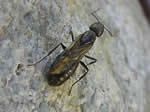
Click on the images to visit the pages.
|
Many birds, like this Red-winged Blackbird, Agelaius phoeniceus, have easy access to things like bulrush seed heads for nest-building since they live in marsh areas and wetlands. However, we know that other birds would love some of this soft stuff for their own nest building! |
| |
|
One idea we like to do is to take a few stalks and pop them into the garden or on the sundeck or bird feeding station.
This little hummingbird seems to be quite happy plucking off some of the fluffy seed for its own nest! |
| |
|
Another source of nesting material that can be attached around the deck is stems of pampas grass. |
| |
|
If you place the pampas in the right spot, you will be able to watch birds come and help themselves and perhaps get some fun photographs. |
| |
The beaks, or more correctly, the bills of birds are cleverly adapted to securing the food they prefer. Here's a quick guide. |
| |
__ |
|
 |
|
The Crackers
Birds like finches, grosbeaks, cardinals and sparrows have cone-shaped bills used to crack open seeds. |
| |
|
|
 |
|
The Pickers
Insect eaters like wrens and warblers have tweezer-like bills which are thin and pointed and useful in picking insects off twigs and leaves. |
| |
|
|
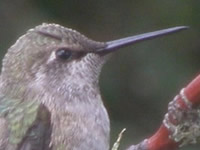 |
|
The Probers
Hummingbirds have long thin bills used like a straw with which they probe flowers to get nectar. |
| |
|
|
 |
|
The Chislers
Woodpeckers and their relatives have strong beaks with a tip used for pecking or drilling holes into wood in their search for grubs and insects underneath the bark. |
| |
|
|
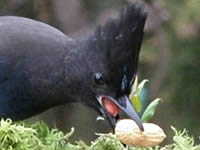 |
|
The Handy Ones
Ravens, jays and crows have multi-purpose bills used for eating seeds, fruit, insects and other food. |
| |
|
|
 |
|
The Rippers
Eagles, hawks owls and other birds of prey have sharp bills with hooks used to rip the flesh of prey. |
| |
|
|
 |
|
The Diggers
Some shore birds like the Black Oystercatcher have long, slender and sometimes curved beaks used for digging into the sand and mud in search of food. |
| |
|
|
 |
|
The Stabbers
Herons and kingfishers have spear-like bills used to stab at or grab fish and other prey. |
| |
|
|
 |
|
The Fishers
Some ducks like the Merganser eat fish and have tooth-like structures around the bill to hold their catch while draining water. |
| |
|
|
 |
|
The Sieves
Birds like Shovelers and Mallards have fringed, flat bills to strain seeds, grubs and plants from water. |
| |
|
|
.jpg) |
|
The Catchers
Birds which catch insects in flight usually have flat, wide bills. Many also have hairs at the base of their bills which are effective in capturing insects. |
| |
This is an abbreviated version of a larger article in the Inn which features more pictures and examples of the different birds and their bills. Visit it here! |
Picture of the Week
 |
|
Be sure to drop by the Inn every week to see the latest Picture of the Week.
You can also do so by clicking on the image to the left or by clicking here. |
|
| |
Past Issues
If you want to see any of the past issues of Whispers, they are available here.
|
|
|

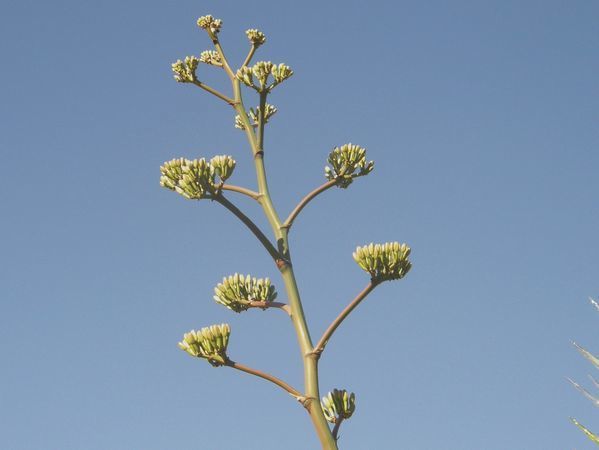 |
Did you know that Century plants don't live for a century? Although it may take many years, the plant actually dies after fruiting, however it produces suckers from its base which continue its growth. |
|
|

 |
New Hampshire designated the pumpkin as the state fruit in 2006. |
| |
|

|
Which mammal started off with the name, Wuckak? It's the Woodchuck, Marmota monax, a name that is derived from an old Algonquian
word wuchak.
The Woodchuck is also called the Groundhog. It is a member of a
rodent family of ground squirrels, which also includes this critter: a
Yellow-bellied Marmot, Marmota flaviventris. |
|
|

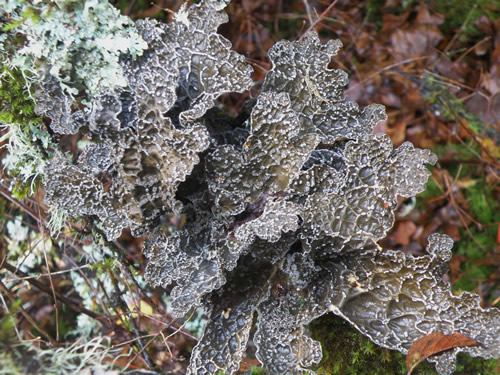 |
This month's mystery is an intriguing lichen: Netted Specklebelly Lichen, Pseudocyphellaria anomala. How well did you fare in solving the mystery??
|
| |
|

|
A mycologist would enjoy studying and learning about
b. fungi.
A mycologist would know that is is a gilled mushroom called a Fly Agaric, Amanita muscaria, and is quite dangerous.
In case you're wondering, Mycology refers to the study of fungi. |
| |
|
|
|
|
|
|
1. Alberta - n. Wild Rose |
|
2. Ontario - m. White Trillium |
| |
|
|
|
|
|
3. Saskatchewan -
l. Western Red Lily
|
|
4. Colorado -
d. Columbine
|
| |
|
|
|
|
|
5. Hawaii -
f. Hibiscus
|
|
6. Illinois -
k. Violet
|
| |
|
|
|
|
|
7. Kansas -
j. Sunflower
|
|
8. Maryland -
c. Black-eyed Susan |
| |
|
|
|
|
|
9. Massachusetts -
g. Mayflower
(makes sense!)
|
|
10. Montana - b. Bitterroot |
| |
|
|
|
|
|
11. Nevada - i. Sagebrush |
|
12. Virginia - a. American Dogwood |
| |
|
|
|
The Leftovers (in case you were wondering) |
|
|
|
Nevada- Goldenrod |
|
Newfoundland and Labrador -
Purple Pitcher Plant |
|
|
|
How well did you do? Here's our scoring guide:
12 - GOLD STAR - Botancial Genius
8 - 11 - SILVER STAR - On the road to great things
5 - 7 - Exhibits potential
0 - 4 - Perhaps you'd do better with a bird quiz! |
| |
|
|
|
Thanks for joining us this month! We hope you enjoyed this issue of Whispers. We invite your comments and ideas - just drop us an e-mail. See you next month! |
|